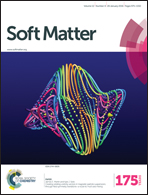Geometric reconstruction of biological orthogonal plywoods†
Abstract
In this paper we focus on the structural determination of biological orthogonal plywoods, fiber-like composite analogues of liquid crystalline phases, where the fibrils of the building blocks show sharp 90° orientation jumps between fibers in adjacent domains. We present an original geometric and computational modelling that allows us to determine the fibrillary orientation in biological plywoods from periodic herringbone patterns commonly observed in cross-sections. Although herringbone patterns were long reported, the specific and quantitative relationships between herringbones and the orthogonal plywoods were absent or at best incomplete. Here we provide an efficient and new procedure to perform an inverse problem that connects two specific features of the herringbone patterns (aperture angle and wavelength) with the 3D morphology of the structure, whose accuracy and validity were ascertained through in silico simulations and also with real specimens (“Eremosphaera viridis”). This contribution extends significantly the better known characterization methods of 2D cross sections, such as the arced patterns observed in biological helicoidal plywoods, and with the present proposed methodology it adds another characterization tool for a variety of biological fibrous composites that form cornea-like tissues.


 Please wait while we load your content...
Please wait while we load your content...